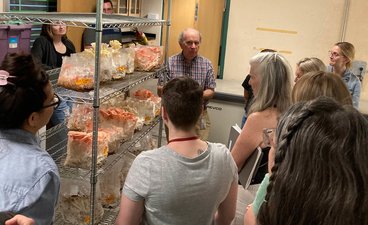While Plant Pathology faculty Bob Blanchette and Megan McCaghey typically use their mycology knowledge to understand plant health, co-teaching a course at the School of Public Health Summer Institute with Carolyn Porta (Associate Vice President for Clinical Affairs and Director of Global Health) provided an exciting opportunity to showcase fungi’s role in human health as well.

The course, titled “Fungi ‘Magic’: An Exploration of Historic and Current Roles of Mushrooms in Health and Preventing Diseases of Humans, Animals, Plants, and the Environment,” consisted of an interdisciplinary set of four lectures plus a hands-on fungi laboratory in Borlaug Hall. Objectives of the course included education on the history and chemistry of medicinal fungi, the current science of psilocybin as a potential therapeutic treatment, broader discussion of the interplay between fungi and other living beings and ecosystems, and the ethical and legal considerations surrounding fungi in human healthcare.
Megan provided details about the variety of fun Plant Path brought to the course: “As part of the class, I provided lectures and facilitated discussions on basic fungal biology and the role of fungi human/animal, plant, and environmental health. Becca and I also prepared stations to provide students with examples of beneficial and harmful/pathogenic fungi. Students also plated common food products such as pasta and flour as part of a lesson about fungi in grains and the impact of mycotoxin-producing fungi. Students then examined the plates that Becca prepared two weeks in advance to demonstrate what their plates would look like with time. Bob led a presentation on the cultural uses and significance of fungi throughout history. He brought examples of fungi to class and provided a tour of his mushroom grow room in St. Paul. He and Nick also prepared slides for students to observe fungal structures, including different spore types, spore-containing structures, and hyphae.”
Bob added, “It was great to see so much interest and enthusiasm in fungi from students coming from so many different fields of study.”
“Overall, I think I learned that there are interdisciplinary teaching opportunities on the biology and impact of fungi that I would like to continue to explore and expand upon,” Megan concluded.
